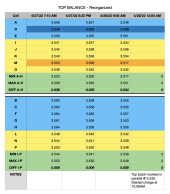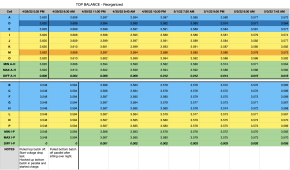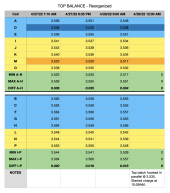You are using an out of date browser. It may not display this or other websites correctly.
You should upgrade or use an alternative browser.
You should upgrade or use an alternative browser.
Top Balancing...Do I need to go to 3.650V?
- Thread starter LivingTheDream
- Start date
MisterSandals
Participation Medalist
Let me back up and reiterate that we want to match based on capacity; putting the lowest capacity cells in one battery and the highest capacity cells in the other.@MisterSandals do you you think it's worthwhile trying to match these cells?
Other than capacity testing all of your cells individually (which i have never done nor do i have a capacity tester), the next best is to watch which cells run away at charge and discharge extremes.
Batch #1:
Earlier I mentioned "positions 3,4,8 and possibly 6 that are different (lower capacity)."
What cell labels are those now? Those are the lower capacity ones in your first batch.
I have been working on a theory as others have also suggested, that "the lower capacity cells self-discharge faster". Is this reflected in your table above? (i cannot tell where cells 3,4,8 and 6 fall into your new labels). Are they cells C,D,F and H?
From your table it looks like B,C,F and H are the fasted discharge cells.
Please confirm labels and how they relate to original numbers.
Batch #2
Lets try to match those with the lower capacity cells in your second batch (presumable I - P labeled above).
The only data we have are the surface charge dissipations over the periods in your table, correct?
LivingTheDream
New Member
- Joined
- Feb 15, 2021
- Messages
- 135
Let me back up and reiterate that we want to match based on capacity; putting the lowest capacity cells in one battery and the highest capacity cells in the other.
Other than capacity testing all of your cells individually (which i have never done nor do i have a capacity tester), the next best is to watch which cells run away at charge and discharge extremes.
Batch #1:
Earlier I mentioned "positions 3,4,8 and possibly 6 that are different (lower capacity)."
What cell labels are those now? Those are the lower capacity ones in your first batch.
I have been working on a theory as others have also suggested, that "the lower capacity cells self-discharge faster". Is this reflected in your table above? (i cannot tell where cells 3,4,8 and 6 fall into your new labels). Are they cells C,D,F and H?
From your table it looks like B,C,F and H are the fasted discharge cells.
Please confirm labels and how they relate to original numbers.
Batch #2
Lets try to match those with the lower capacity cells in your second batch (presumable I - P labeled above).
The only data we have are the surface charge dissipations over the periods in your table, correct?
The cells that you were eluding to (3,4,8,6) are from the second batch. So they are now labeled K,L,N,P.
MisterSandals
Participation Medalist
That’s a couple more data points. If these were the low capacity cells, they did not show faster surface charge loss. (Dang for my theory!)The cells that you were eluding to (3,4,8,6) are from the second batch. So they are now labeled K,L,N,P.
I would keep these 4 together and migrate any other low capacity cells to this group (and high capacity away) as you discover them.
What is your plan?
LivingTheDream
New Member
- Joined
- Feb 15, 2021
- Messages
- 135
Well, in analyzing the discharge of both sets, cell D and cell M are losing it the fastest. The margins seem so low, but I'm not an expert on this. So I'm taking three cells from batch one, and five cells from the second batch to make a "theoretically" matched lower capacity batch.That’s a couple more data points. If these were the low capacity cells, they did not show faster surface charge loss. (Dang for my theory!)
I would keep these 4 together and migrate any other low capacity cells to this group (and high capacity away) as you discover them.
What is your plan?

LivingTheDream
New Member
- Joined
- Feb 15, 2021
- Messages
- 135
LivingTheDream
New Member
- Joined
- Feb 15, 2021
- Messages
- 135
Hello Everyone,
With all the cells repositioned to take advantage of the cells with the slowest rate of discharge paired together and vice versa, I see that there are mainly one cell (D) that has the highest rate of discharge. Do you think these bad boys are ready to build my packs and put into service? In five days, the delta on the top batch is at .018 and would be .010 if it wasn't for that one cell. The bottom batch seems spot on at .005 in 4.5 days. Seems like I could move on to asking other questions now. LOL!
p.s. You think I should just return this active balancer since I never used it, or will it still be needed?
TYIA,
Brian

With all the cells repositioned to take advantage of the cells with the slowest rate of discharge paired together and vice versa, I see that there are mainly one cell (D) that has the highest rate of discharge. Do you think these bad boys are ready to build my packs and put into service? In five days, the delta on the top batch is at .018 and would be .010 if it wasn't for that one cell. The bottom batch seems spot on at .005 in 4.5 days. Seems like I could move on to asking other questions now. LOL!
p.s. You think I should just return this active balancer since I never used it, or will it still be needed?
TYIA,
Brian

DerpsyDoodler
Solar Addict
- Joined
- Jan 10, 2021
- Messages
- 2,246
Do you expect them to be sitting 5 days in between charge/discharge cycles?
LivingTheDream
New Member
- Joined
- Feb 15, 2021
- Messages
- 135
No, I'll be hooking them up to 1620w of solar on the RV. From what I can see, I'll need to set the parameters on the charge controller to keep them between 20-90%. At least that's what I think I remember reading.Do you expect them to be sitting 5 days in between charge/discharge cycles?
John Frum
Tell me your problems
- Joined
- Nov 30, 2019
- Messages
- 15,230
You need to charge into the high knee on a regular basis to maintain the top balance.No, I'll be hooking them up to 1620w of solar on the RV. From what I can see, I'll need to set the parameters on the charge controller to keep them between 20-90%. At least that's what I think I remember reading.
How regular depends on the cells and the bms balancing capacity.
A charge voltage >=3.45 volts will get your batteries better than 99% full.
I suggest your bandwidth managment target be 99%-15%.
LivingTheDream
New Member
- Joined
- Feb 15, 2021
- Messages
- 135
Good to know. I thought I remembered hearing that for RV usage, you didn't want to go that high. However, I don't recall at all where I read that on here or who said it.You need to charge into the high knee on a regular basis to maintain the top balance.
How regular depends on the cells and the bms balancing capacity.
A charge voltage >=3.45 volts will get your batteries better than 99% full.
I suggest your bandwidth managment target be 99%-15%.
John Frum
Tell me your problems
- Joined
- Nov 30, 2019
- Messages
- 15,230
Its a common idea.Good to know. I thought I remembered hearing that for RV usage, you didn't want to go that high. However, I don't recall at all where I read that on here or who said it.
But in my opinion its not a very good idea.
Similar threads
- Replies
- 4
- Views
- 395
- Replies
- 8
- Views
- 538
- Replies
- 23
- Views
- 1K
- Replies
- 2
- Views
- 210



